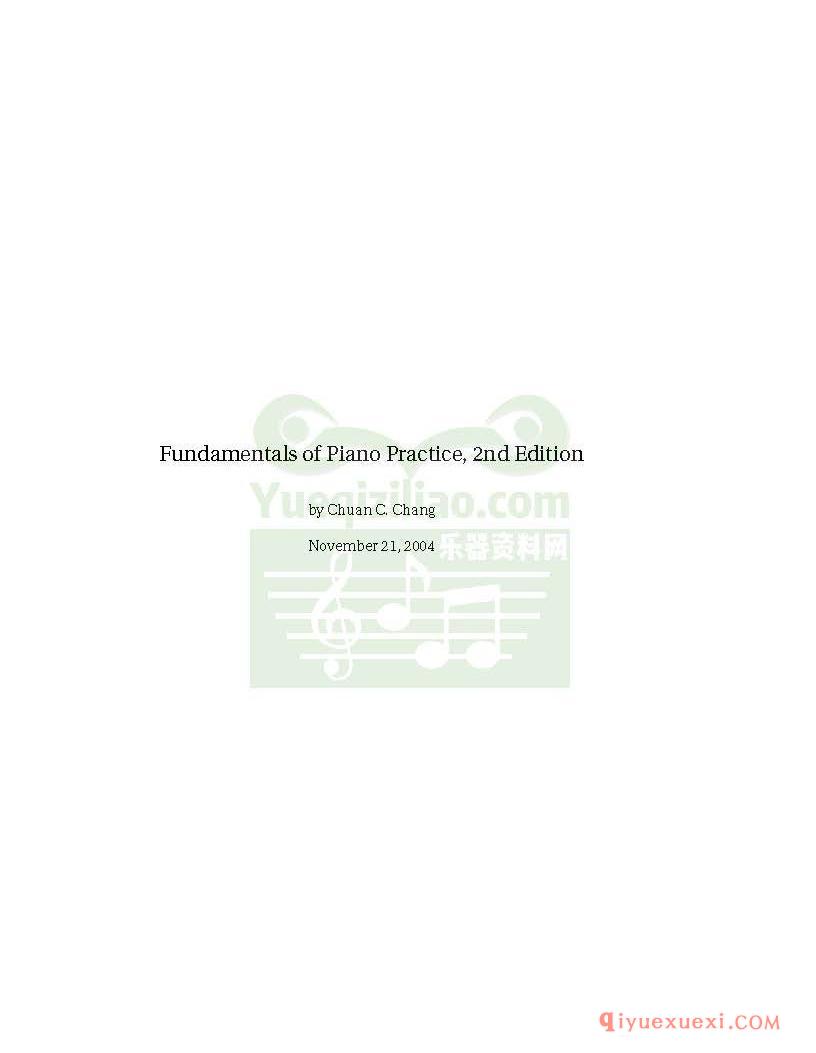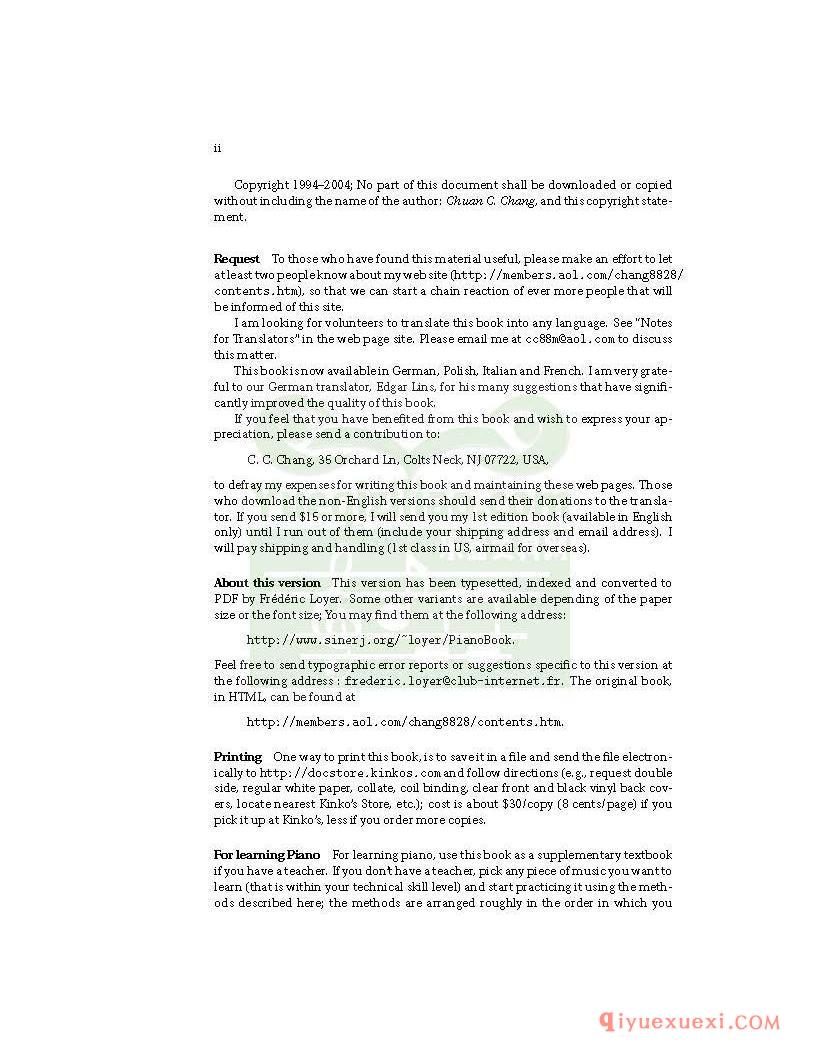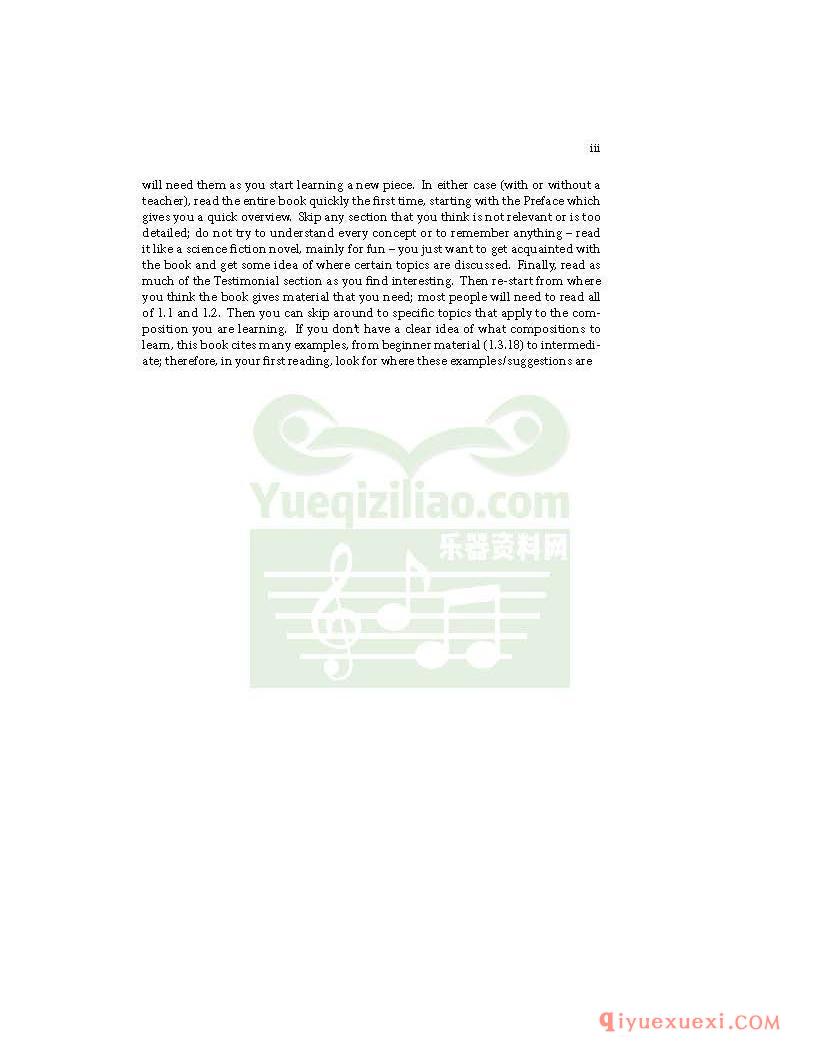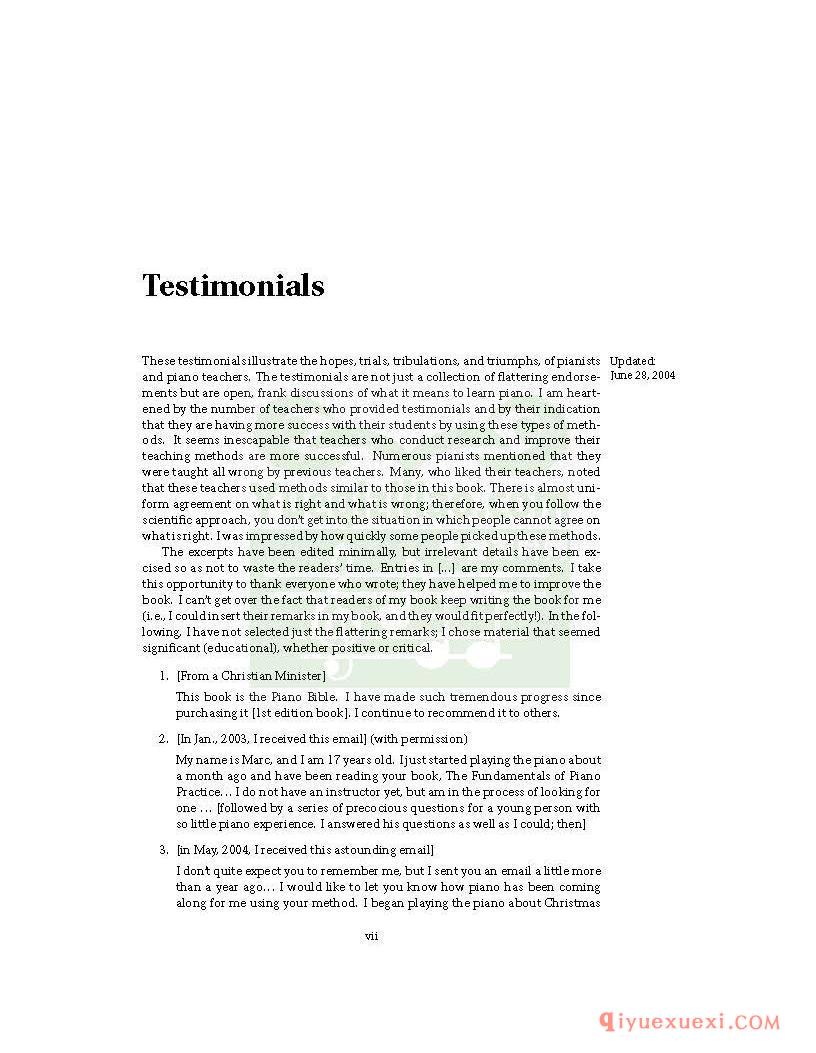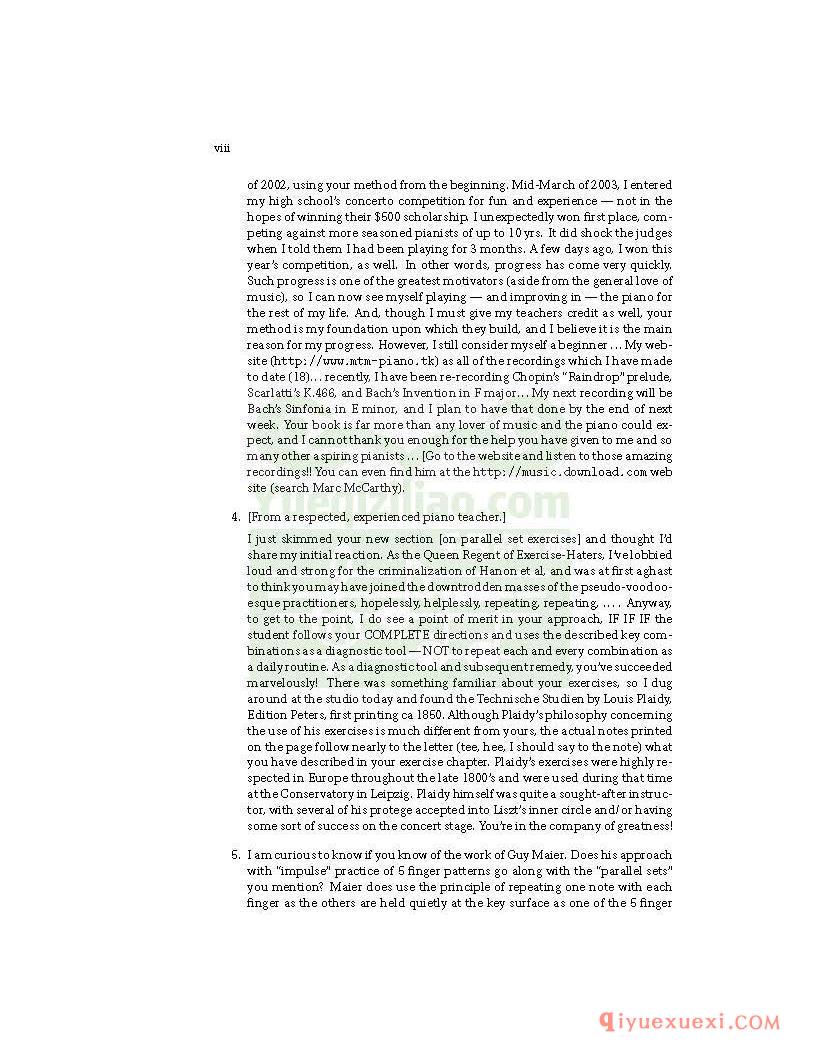PDF钢琴教材下载 | 钢琴练习基础第 2 版(Fundamentals Of Piano Practice ,2nd Edition)原版电子书
佚名 网络英文名称:Fundamentals Of Piano Practice ,2nd Edition
中文名称:钢琴练习基础.第 2 版
目录如下
Testimonials|chapter*.5
Preface|chapter*.6
Contents|chapter*.7
Technique|chapter.1
Introduction|section.1.1
Objective|subsection.1.1.1
What is Piano Technique?|subsection.1.1.2
Technique and Music|subsection.1.1.3
Basic Approach, Interpretation, Musical Training, Perfect Pitch|subsection.1.1.4
Basic Procedures for Piano Practice|section.1.2
The Practice Routine|subsection.1.2.1
Finger Positions|subsection.1.2.2
Bench Height and Distance from Piano|subsection.1.2.3
Starting a Piece: Listening and Analysis (Für Elise)|subsection.1.2.4
Practice the Most Difficult Sections First|subsection.1.2.5
Shortening Difficult Passages: Segmental (Bar-by-Bar) Practice|subsection.1.2.6
Hands Separate Practice: Acquiring Technique|subsection.1.2.7
The Continuity Rule|subsection.1.2.8
The Chord Attack|subsection.1.2.9
Gravity Drop, Chord Practice, and Relaxation|subsection.1.2.10
Parallel Sets|subsection.1.2.11
Learning and Memorizing|subsection.1.2.12
Velocity, Choice of Practice Speed|subsection.1.2.13
How to Relax|subsection.1.2.14
Post Practice Improvement (PPI)|subsection.1.2.15
Dangers of Slow Play --- pitfalls of the intuitive method|subsection.1.2.16
Importance of Slow Play|subsection.1.2.17
Fingering|subsection.1.2.18
Accurate Tempo and the Metronome|subsection.1.2.19
Weak Left Hand; Using One Hand to Teach the Other|subsection.1.2.20
Building Endurance, Breathing|subsection.1.2.21
Bad Habits: A Pianist's Worst Enemy|subsection.1.2.22
Damper Pedal|subsection.1.2.23
Soft Pedal, Timbre, and Normal Modes of Vibrating Strings|subsection.1.2.24
Hands Together: Chopin's Fantaisie Impromptu|subsection.1.2.25
Summary|subsection.1.2.26
Selected Topics in Piano Practice|section.1.3
Tone, Rhythm, and Staccato|subsection.1.3.1
What is ``Good Tone''?|subsubsection.1.3.1.1
What is Rhythm?|subsubsection.1.3.1.2
Staccato|subsubsection.1.3.1.3
Cycling (Chopin's Fantaisie Impromptu)|subsection.1.3.2
Trills & Tremolos|subsection.1.3.3
Trills|subsubsection.1.3.3.1
Tremolos (Beethoven's ``Pathétique'', 1st Movement)|subsubsection.1.3.3.2
Hand, Body Motions for Technique|subsection.1.3.4
Hand Motions|subsubsection.1.3.4.1
Playing with Flat Fingers|subsubsection.1.3.4.2
Body Motions|subsubsection.1.3.4.3
Playing (Fast) Scales and Arpeggios (Chopin's Fantaisie Impromptu and Beethoven's Moonlight, 3rd Movement)|subsection.1.3.5
Scales|subsubsection.1.3.5.1
Arpeggios|subsubsection.1.3.5.2
The Cartwheel motion Method (Chopin's FI)|subsubsection.1.3.5.3
Thrust and Pull: the two principal ways to play the arpeggio.|subsubsection.1.3.5.4
Thumb: the most versatile finger, and Example of Scale/Arpeggio Practice Routine|subsubsection.1.3.5.5
Memorizing|subsection.1.3.6
Why Memorize?|subsubsection.1.3.6.1
Who can, What to, and When to, Memorize.|subsubsection.1.3.6.2
Memorizing and Maintenance|subsubsection.1.3.6.3
Hand Memory|subsubsection.1.3.6.4
Starting the Memorizing Process|subsubsection.1.3.6.5
Reinforcing the Memory|subsubsection.1.3.6.6
Practicing Cold|subsubsection.1.3.6.7
Slow Play|subsubsection.1.3.6.8
Mental Timing|subsubsection.1.3.6.9
Establishing Permanent Memory|subsubsection.1.3.6.10
Maintenance|subsubsection.1.3.6.11
Sight Readers versus Memorizers: Learning Bach's Inventions|subsubsection.1.3.6.12
Human Memory Function|subsubsection.1.3.6.13
A Simple Method for Becoming a Good Memorizer|subsubsection.1.3.6.14
Summary|subsubsection.1.3.6.15
Exercises|subsection.1.3.7
Introduction : Intrinsic, Limbering, and Conditioning Exercises|subsubsection.1.3.7.1
Parallel Set Exercises for Intrinsic Technical Development|subsubsection.1.3.7.2
How To Use The Parallel Set Exercises|subsubsection.1.3.7.3
Scales, Arpeggios, Finger Independence and Finger Lifting Exercises|subsubsection.1.3.7.4
Playing (Wide) Chords, Palm Stretching Exercises|subsubsection.1.3.7.5
Practicing Jumps|subsubsection.1.3.7.6
Stretching and Other Exercises|subsubsection.1.3.7.7
Problems with Hanon Exercises|subsubsection.1.3.7.8
Practicing for Speed|subsubsection.1.3.7.9
Outlining (Beethoven's Sonata #1)|subsection.1.3.8
Polishing a Piece --- Eliminating Flubs|subsection.1.3.9
Cold Hands, Illness, Hand Injury, Ear Damage|subsection.1.3.10
Cold Hands|subsubsection.1.3.10.1
Illness|subsubsection.1.3.10.2
Most Injury|subsubsection.1.3.10.3
Ear Damage|subsubsection.1.3.10.4
Sight Reading|subsection.1.3.11
Learning Relative Pitch and Perfect Pitch (Sight Singing)|subsection.1.3.12
Videotaping and Recording Your Own Playing|subsection.1.3.13
Audio Recording|subsubsection.1.3.13.1
Camcorders|subsubsection.1.3.13.2
Preparing for Performances and Recitals|subsection.1.3.14
Why Do Some Pianists Never Perform?|subsubsection.1.3.14.1
Benefits and Pitfalls of Performances/Recitals|subsubsection.1.3.14.2
Preparing for Performances/Recitals|subsubsection.1.3.14.3
Practicing for Performances and Playing Musically|subsubsection.1.3.14.4
Casual Performances|subsubsection.1.3.14.5
Preparation Practice Routines|subsubsection.1.3.14.6
During the Recital|subsubsection.1.3.14.7
That Unfamiliar Piano|subsubsection.1.3.14.8
After the Recital|subsubsection.1.3.14.9
Origin and Control of Nervousness|subsection.1.3.15
Teaching|subsection.1.3.16
Types of Teachers|subsubsection.1.3.16.1
Teaching Youngsters|subsubsection.1.3.16.2
Memorizing, Reading, Theory|subsubsection.1.3.16.3
Some Elements of Piano Lessons|subsubsection.1.3.16.4
Why the Greatest Pianists Could Not Teach|subsubsection.1.3.16.5
Upright, Grand & Electronic Pianos; Purchasing and Care|subsection.1.3.17
Grand, Upright, or Electronic?|subsubsection.1.3.17.1
Electronic Pianos|subsubsection.1.3.17.2
Uprights|subsubsection.1.3.17.3
Grands|subsubsection.1.3.17.4
Purchasing an Acoustic Piano|subsubsection.1.3.17.5
Piano Care|subsubsection.1.3.17.6
How to Start Learning Piano: Youngest Children to Old Adults|subsection.1.3.18
Do You Need a Teacher?|subsubsection.1.3.18.1
Starter Books and Keyboards|subsubsection.1.3.18.2
Beginners: Age 0 to 65+|subsubsection.1.3.18.3
The ``Ideal'' Practice Routine (Bach's Teachings and Invention #4)|subsection.1.3.19
Learning the Rules|subsubsection.1.3.19.1
Routine for Learning a New Piece (Invention #4)|subsubsection.1.3.19.2
``Normal'' Practice Routines and Bach's Teachings|subsubsection.1.3.19.3
Bach: the Greatest Composer and Teacher (15 Inventions and their Parallel Sets)|subsection.1.3.20
The Psycology|subsection.1.3.21
Outline Summary of Entire Method|subsection.1.3.22
Mathematical Theory of Piano Playing|section.1.4
Why do we need a Mathematical Theory?|subsection.1.4.1
The Theory of Finger Motion for Piano|subsection.1.4.2
Thermodynamics of Piano Playing|subsection.1.4.3
Mozart's Formula, Beethoven and Group Theory|subsection.1.4.4
Learning Rate Calculation (1000 Times Faster!)|subsection.1.4.5
Future Research Topics|subsection.1.4.6
Tuning Your Piano|chapter.2
Introduction|section.2.1
Chromatic Scale and Temperament|section.2.2
Tuning Tools|section.2.3
Preparation|section.2.4
Getting Started|section.2.5
Tuning Procedures and Temperament|section.2.6
Tuning the Piano to the Tuning Fork|subsection.2.6.1
Kirnberger II|subsection.2.6.2
Equal Temperament|subsection.2.6.3
Making Minor Repairs|section.2.7
Hammer Voicing|subsection.2.7.1
Polishing the Capstans|subsection.2.7.2
Scientific Method, Theory of Learning and the Brain|chapter.3
Introduction|section.3.1
The Scientific Approach|section.3.2
What is the Scientific Method?|section.3.3
Theory of Learning|section.3.4
What Causes Dreams and Methods for Controlling Them|section.3.5
The Falling Dream|subsection.3.5.1
Inability-to-Run Dream|subsection.3.5.2
Late-to-Exams or Getting-Lost Dream|subsection.3.5.3
Solving My Long and Complex Dream|subsection.3.5.4
Controlling the Dreams|subsection.3.5.5
What these Dreams Teach Us about our Brain|subsection.3.5.6
How to Use Your Subconscious Brain|section.3.6
Emotions|subsection.3.6.1
Using the Subconscious Brain|subsection.3.6.2
References|appendix.A
List of Abbreviations|appendix.B
Index|section*.93
下载地址及介绍
| 文件类型 | PDF电子书 |
| 文件大小 | 1.90 MB |
| 文件页数 | 354页 |
| 下载地址 | 百度网盘 |
| 提取码 | vw3x |
| 解压密码 | qiyuexuexi.com |
封面及部分谱例
